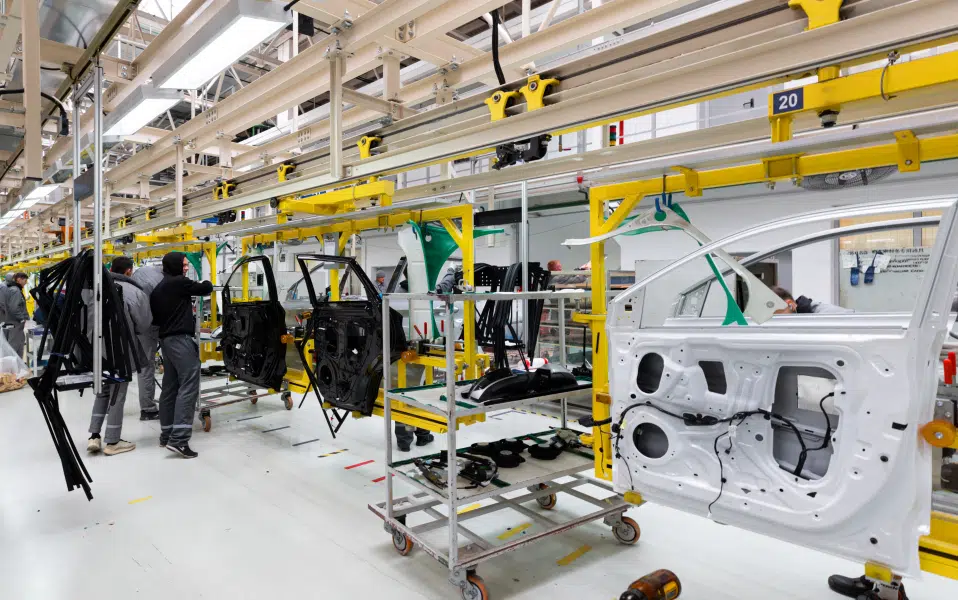Electric Monorail Systems
Rail systems with individually controllable carriages
Rail systems with power and data supply
The rail systems of Electric Monorail Systems can be completely virtually mapped using the WinMOD-SIMLINE system. For this purpose, there are 3D rail libraries that include straight sections, curves, switches, crossings, lifting/lowering units and turning devices. All of these elements can be freely parameterised in terms of size and shape, allowing any real rail layout to be virtually recreated in 3D. Each of our 3D rail elements has an interface for power and data supply via conductor rail or bus. It is also possible to report the vehicle status back to the current rail. Of course, you can also stick code tapes onto the virtual rails, which are read in real time by the vehicle code readers during virtual commissioning (VC).
Combination with other technologies is possible without any problems. This allows you to accurately simulate transfer processes to SKID, push SKID or even complex wedding stations.


Light and heavy-duty vehicles
The focus of VC for EHB systems is on the behaviour of the carriages with their own controllers and freely programmable, asynchronous travel profiles. Both manufacturer-neutral and specific 3D libraries are available for the carriages.
For heavy-duty vehicles, we simulate the exact driving behaviour of complex drive and roller configurations. The complex frame mechanics, which are combinations of lifting, rotating, swivelling and folding frames, are simulated with precise geometry and the associated drive technology. Other important elements in WinMOD-SIMLINE vehicles are position and anti-collision sensors as well as code readers for RFID and barcodes.
The real-time Electric Monorail Systems simulation is undoubtedly one of the showpieces of the WinMOD-SIMLINE system. It has been used successfully by renowned car manufacturers for many years.
Further automotive engineering solutions
Production area in which structural body parts and outer skin parts are produced from sheet metal coils or cut-to-size blanks (blanks) by cold or hot forming – from the raw blank to the ready-to-install formed part.
Assembles stamped/formed sheet metal parts, extruded and cast components into a dimensionally accurate body structure – with defined geometry, rigidity, crash and NVH performance as the basis for the paint shop and final assembly.
Highly automated plant chains for surface pre-treatment, coating and curing of car bodies and add-on parts – designed for high throughput, reproducible appearance and corrosion protection.
Pre-assembly of front/rear axle modules as carriers for chassis, steering and drive units such as combustion engines, powertrains or electric axles. Transport to the sequenced handover to the „marriage“ with the body.
Highly automated process chain for the fabrication of traction batteries – from electrode production to cell assembly and forming to module/pack assembly
This area of technology encompasses conveyor systems that transport and sort pallets and mesh boxes containing automotive components. The conveyor elements are large roller and chain conveyors combined with lifting, rotating and shifting tables.
Fully automated high-bay warehouses, which are operated by light or heavy-duty storage and retrieval machines and controlled by distributed automation systems. Warehouse management systems generate the orders for storing and retrieving raw components or complete car bodies.
Ground-based conveyor technology in which car bodies or heavy modules are transported on standardised SKIDs (steel frames with vehicle-specific support points) through assembly, paint shop and buffer areas.
Overhead conveyor systems with electrically driven, individually controllable trolleys on monorail tracks for low or high loads (up to tonnes).
Ground-based conveyor technology in which car bodies or heavy assemblies are moved on platforms along rails. The drive is typically provided by friction wheels, push chain conveyors or push beams, which continuously push the SKIDs forward.